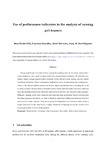Use of performance indicators in the analysis of running gait impacts

Use this link to cite
http://hdl.handle.net/2183/29401
Except where otherwise noted, this item's license is described as Atribución-NoComercial-SinDerivadas 3.0 España
Collections
- Investigación (EPEF) [589]
Metadata
Show full item recordTitle
Use of performance indicators in the analysis of running gait impactsAuthor(s)
Date
2018Citation
Pàmies-Vilà, R., González, F., Kövecses, J. et al. Use of performance indicators in the analysis of running gait impacts. Multibody Syst Dyn 43, 131–151 (2018). https://doi.org/10.1007/s11044-017-9580-9
Abstract
[Summary]
Foot-ground impact is a critical event during the running cycle. In this work, three performance indicators were used to characterize foot-ground impact intensity: the effective preimpact kinetic energy, representative elements of the effective mass matrix, and the critical coefficient of friction. These performance indicators can be obtained from the inertial properties of the biomechanical system and its pre-impact mechanical state, avoiding the need to carry out force measurements. Ground reaction forces and kinematic data were collected from the running motion of an adult that adopted both rear-foot and fore-foot strike patterns. Different running cycles were analysed and statistical tests performed. Results showed that the three proposed indicators are able to illustrate significant differences between fore-foot and rear-foot strike impacts. They also support the hypothesis that fore-foot strike reduces impact intensity. On the other hand, a higher likelihood of slipping during the contact onset is associated with fore-foot strike pattern.
Keywords
Biomechanics
Running
Impact dynamics
Foot strike
Performance indicators
Biomecánica
Dinámica de impacto
Pisada
Indicadores de rendimiento
Running
Impact dynamics
Foot strike
Performance indicators
Biomecánica
Dinámica de impacto
Pisada
Indicadores de rendimiento
Editor version
Rights
Atribución-NoComercial-SinDerivadas 3.0 España






